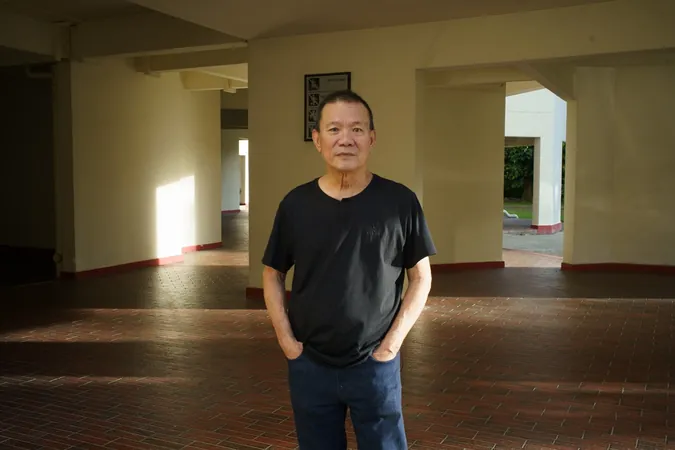
Grab's EV Revolution: A Bold Move Towards Sustainable Transportation in Southeast Asia
2025-01-20
Author: Wei Ling
Grab's EV Revolution: A Bold Move Towards Sustainable Transportation in Southeast Asia
In a game-changing partnership, Grab has unveiled plans to enhance its electric vehicle (EV) fleet by integrating a staggering 50,000 BYD electric vehicles across Southeast Asia. This strategic alliance not only signifies Grab's commitment to sustainable transportation but also positions the company as a leader in the region's electric mobility revolution.
According to Grab, this collaboration aims to significantly accelerate the electrification of the transportation sector in Southeast Asia, with a strong emphasis on environmental sustainability. "Through this partnership, Grab and BYD look to boost the electrification of the transportation sector in Southeast Asia," the company stated, expressing optimism about a greener future.
However, this ambitious initiative is not without its challenges. Analyst insights reveal that countries like Indonesia, Thailand, and Vietnam are lagging behind Singapore and Malaysia in developing the necessary EV infrastructure. While Singapore has made considerable investments in charging stations, questions arise about whether this infrastructure is sufficient to support a substantial influx of electric vehicles from ride-hailing services like Grab.
The partnership shines a light on the financial advantages it brings for Grab drivers. By providing access to BYD vehicles at competitive rates and extended battery warranties, Grab aims to lower the financial barriers typically associated with owning or operating electric vehicles. This is particularly crucial as Grab operates in diverse regions including Cambodia, Indonesia, Malaysia, Myanmar, the Philippines, Singapore, Thailand, and Vietnam, each with its own market dynamics.
Notably, analysts suggest that Singapore may not be the primary beneficiary of the 50,000 EVs due to its smaller market size compared to the rapidly growing markets in Malaysia and Indonesia. "If I look at sheer market size, I don’t think Singapore will attract a significant majority of the 50,000 cars," commented Associate Professor Raymond Ong from the National University of Singapore.
Despite the logistical challenges, Grab’s initiative reinforces the growing interest and investment in EV infrastructure across the region. Yet, for wider adoption, Southeast Asia must address critical issues such as the availability of affordable EV models and an extensive network of charging stations. Grab recognizes these hurdles and remains committed to tackling them by working alongside various players within the EV ecosystem to implement innovative solutions.
In Singapore specifically, the shift towards electric vehicles is accompanied by challenges unique to the market. For private-hire drivers, who log more mileage than traditional EV owners, the requirement for daily charging poses logistical issues. While Grab has initiated partnerships with six major EV charging providers in Singapore — including SP Mobility and Shell — to offer discounts and reduce operational costs for drivers, these solutions are still in the early stages.
Passengers in Singapore and Thailand will soon enjoy the option of selecting "eco-friendly rides" via the Grab app, allowing them to prioritize greener transportation without additional charges. However, experts suggest that most passengers are not likely to pay extra for EV rides unless they include premium offerings.
Furthermore, the collaboration with BYD also involves integrating Internet of Things (IoT) technology into Grab's platform. This advanced connectivity will enable real-time data sharing, allowing Grab to optimize ride allocations based on demand and environmental conditions. These technological enhancements are set to reduce wait times for passengers, improving overall service quality.
As Grab takes significant strides towards a more sustainable future, the move represents not just an evolution in ride-hailing but a pivotal moment for the entire Southeast Asian transportation landscape. Will this bold initiative pave the way for a greener, more efficient future? Only time will tell.



 Brasil (PT)
Brasil (PT)
 Canada (EN)
Canada (EN)
 Chile (ES)
Chile (ES)
 Česko (CS)
Česko (CS)
 대한민국 (KO)
대한민국 (KO)
 España (ES)
España (ES)
 France (FR)
France (FR)
 Hong Kong (EN)
Hong Kong (EN)
 Italia (IT)
Italia (IT)
 日本 (JA)
日本 (JA)
 Magyarország (HU)
Magyarország (HU)
 Norge (NO)
Norge (NO)
 Polska (PL)
Polska (PL)
 Schweiz (DE)
Schweiz (DE)
 Singapore (EN)
Singapore (EN)
 Sverige (SV)
Sverige (SV)
 Suomi (FI)
Suomi (FI)
 Türkiye (TR)
Türkiye (TR)
 الإمارات العربية المتحدة (AR)
الإمارات العربية المتحدة (AR)